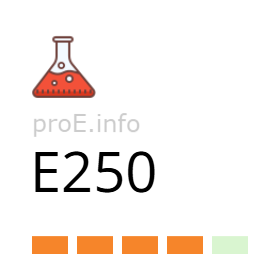
Other names for the additive (synonyms)
General Information
The additive E250 (sodium nitrite) is used in the food industry as a color fixative and preservative in meat and fish products.
The chemical formula of sodium nitrite is NaNO2. In its pure form, it is a white hygroscopic crystalline powder with a slightly yellowish tint and is highly soluble in water. When exposed to air, it undergoes slow oxidation to form sodium nitrate (NaNO3).
Industrial use of sodium nitrite began in 1906 after its beneficial properties in meat production were discovered. Today, it is obtained through a reaction of sodium compounds with substances containing the nitrite ion in an aqueous medium. The resulting precipitate is evaporated and cooled to produce the powder used as the preservative E250.
For the food industry, sodium nitrite is produced exclusively by synthetic means. However, in the human and animal stomach, a portion of nitrates consumed with food (e.g., from vegetables) can be converted into small amounts of nitrites by the digestive system’s microflora.
Effects on the Body
Risks of additive E250
Sodium nitrite is a highly toxic substance — the lethal dose for humans is 2–6 g. Improper use of additive E250 (e.g., incorrect dosing or poor mixing in ground meat) can lead to severe poisoning of the final product. That is why preservative E250 is used in a mixture with table salt.
Scientific publications report cases of lethal sodium nitrite ingestion for suicide. The mechanism of death from sodium nitrite poisoning involves severe hypoxia due to the oxidation of divalent iron (Fe2+) in hemoglobin to trivalent iron (Fe3+), which prevents oxygen from being efficiently transported through the bloodstream to the body’s cells.
A meta-analysis of 49 studies showed that high intake of nitrites may lead to stomach cancer.
An article by The Guardian compiles data and findings from various studies indicating that meat products treated with sodium nitrite are essentially carcinogenic and may increase the risk of cancer due to the formation of nitrosamines.
Nitrosamines are carcinogenic compounds that may form during the cooking of meat products containing sodium nitrite, or as a result of the reaction of nitrite with secondary amines in acidic conditions (e.g., in the human stomach).
However, it is difficult to completely eliminate foods containing nitrites and nitrates from the diet, as they are also found in small amounts in vegetables and fruits (tomatoes, potatoes, strawberries, etc.).
Doctors recommend increasing the intake of vitamins C and E, which inhibit the formation of nitrosamines.
Nitrites are easily absorbed in the gastrointestinal tract, can reduce muscle tone, dilate blood vessels, and lower blood pressure, though such effects are observed only at doses far exceeding those used in food products.
Benefits of additive E250
Additive E250 itself does not have any direct positive effects on the human body. However, at concentrations used in the food industry, E250 effectively prevents the growth of dangerous bacteria, including Clostridium botulinum, which causes botulism.
The antimicrobial action of sodium nitrite is observed at doses of 50–160 mg per 1 kg of finished product. At such levels, preservative E250 is considered harmless to human health.
In 2017, the Panel on Food Additives and Nutrient Sources added to Food (ANS Panel) published a scientific opinion on the re-evaluation of sodium nitrite safety and established an Acceptable Daily Intake (ADI) of 0.07 mg/kg body weight per day.
Uses
Additive E250 is used in the meat industry to fix color, prevent oxidation, and inhibit microbial spoilage. It is especially effective against Clostridium botulinum bacteria. Sodium nitrite is also used:
- in medicine — as a vasodilator, an antidote for cyanide poisoning, and a treatment for bronchial diseases;
- in construction — as an additive to concrete to increase frost resistance;
- in the chemical industry — for the production of dyes and nitro compounds;
- in the textile industry — in fabric dyeing processes;
- in automobiles — as a heat carrier in antifreeze;
- in industry — as a corrosion inhibitor;
- in photography — as a reagent for image processing.
In some cases, additive E250 is replaced by the safer potassium sorbate (E202), but the latter cannot impart the desired color and aroma to meat products.
Legal Status
Additive E250 is approved for use in the food industry in Ukraine, the European Union, the United States, and other countries.
In most countries, the maximum allowed level of additive E250 is 50 mg per kg of finished product. In the European Union, sodium nitrite is permitted only as a component of curing mixtures at concentrations up to 0.6%. Strict storage and handling requirements apply in facilities where preservative E250 is used.